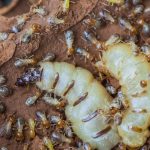How to Identify a Termite Infestation
How can you tell if termites are on your property? Identifying the signs requires a bit of knowledge. We’ve got a few tips for you to catch termites early before you have an infestation on your hands! Check out our guide below to finding termites in your home, before it’s too late!
Mud Tubes
Termites travel through mud tubes to access their food sources and colony. The tubes protect termites from predators and are the perfect environment for food storage. Colonies build these structures at night when they’re least likely to be disturbed. In most cases, the tubes are brown and hold a clay-like texture. Tubes that are large protect millions of workers, transporting food to their colonies.
Blowholes in Trees
The subterranean termite species forms their colonies around the root or crown of tree trunks. When an enemy infests the termites, alates cut a longitudinal slit in the tree trunk to exit. When the fight is complete the worker termites seal the hole; then the tree will produce a callus in responses to injuries. If a hollow sound is produced when striking wood on your property, you may have a termite infestation on your hands.
Wings
Reproductive termites, also known as swarmers, regularly take flights to seek out a new home for their colony. If you see discarded wings around your property, you should do a thorough check for termites. Wings are a sign that swarmers are near, and on the lookout for a new home.
Sagging Floors and Hollow Wood
Termites burrow into wood in a honeycomb pattern, without coming close to the surface. This pattern can make early detection difficult. As they continue to burrow wood weakens significantly, resulting in sagging floors and hollow sounds. If you spot hollow, burrowed wood in your home avoid walking on it to avoid injury and further damage.




